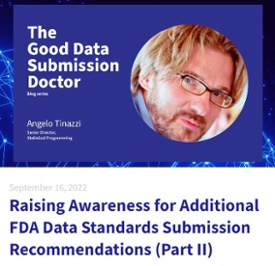Raising Awareness for FDA Data Submission Recommendations (I)

For years CDISC data standards implementers have struggled to find good implementation examples and use cases beside those provided in the CDISC Implementation Guidance (IG). However, in the recent years, thanks to the efforts of several different experts, such as clinicians in the different Therapeutic Areas or data standards experts, several CDISC Therapeutic Area User Guidance (TAUG) have been made available [1, 2, 3]. As I write this blog, 46 TAUGs are available from various therapeutic areas, such as Oncology, Neurology, Endocrinology, Cardiovascular, Infective Diseases, Autoimmune Diseases, Mental Health, Gastrointestinal, and others. The use of and adherence to many of these TAUGs is recommended by the FDA in its Study Data Technical Conformance Guidance (SDTCG) [4], and as per the March-2022 version, 24 TAUGs are “supported”.
Moreover, regulatory agencies such as the FDA have also released some additional guidances either specific to an FDA division or covering any specific medical aspects, with the aim of reducing the variability in interpretation of CDISC IG. In a previous blog , I discussed the detailed ADaM specifications provided by the FDA Office of Oncologic Diseases in support of Real Time Oncology Review [5].
Despite the following statement in most if not all FDA guidances, the FDA divisions expect that these recommendations are followed, and this is also confirmed by some comments we received during certain pre-NDA and pre-BLA meetings:
“In general, FDA’s guidance documents do not establish legally enforceable responsibilities. Instead, guidances describe the Agency’s current thinking on a topic and should be viewed only as recommendations, unless specific regulatory or statutory requirements are cited. The use of the word should in Agency guidances means that something is suggested or recommended, but not required”
Ironically, the “abundance” of guidances and agency recommendations, aka “requirements”, has complicated the work of data standards implementers, as also discussed by the Pfizer programming team at PHUSE-US 2020 [6]. This is even more true in the CRO world where “specialization” is less common than on the Sponsor side where data standards implementers can focus on few therapeutic areas, often one, thus becoming experts on those therapeutic areas. Recently, during a bid defense meeting a sponsor asked us if our programming team has been “educated” on an FDA guidance specific to Vaccines [7] data submission; obviously, with more than 300 programmers, biostatisticians, and data managers, it is challenging to accomplish such a requirement and expect that all our employees are familiar with the content of more than fifty documents.
The only possible approach is "raising the awareness” which means having a data standards governance team in place, like the one we have at Cytel, that is responsible for regularly assessing new guidance, “digesting” and making them available to the rest of the team, and ensuring that everyone who is dealing with data standards is aware that some specific requirements may be available in the therapeutic area or specific indications that they are working on.
All these guidances are referenced in the FDA SDTCG in section
“5. List of FDA Technical Specification Documents,” on the Study Data Standards Resources FDA webpage in section “3. Technical Guidance,” [8] and listed in the following table:
| # | FDA Additional Data Standards Guidance References |
| 1 | Vaccines Technical Specification Guidance v2.1 (December 2019) https://www.fda.gov/media/112581/download |
| 2 | QT Studies Technical Specification Document v1.0 (June 2019) https://www.fda.gov/media/128187/download |
| 3 | Submitting Select Clinical Trial Data Sets for Drugs Intended to Treat Human Immunodeficiency Virus-1 Infection (March 2018) https://www.fda.gov/media/112667/download |
| 4 | Technical Specifications—Comparative Clinical Endpoint Bioequivalence Study Analysis Datasets for Abbreviated New Drug Applications (September 2018) https://www.fda.gov/media/116187/download |
| 5 | Technical Specifications for Submitting Clinical Trial Data Sets for Treatment of Noncirrhotic Nonalcoholic Steatohepatitis (NASH) (January 2022) [9] https://www.fda.gov/media/151864/download |
| 6 | Submitting Next Generation Sequencing Data to the Division of Antiviral Products v1.0 (July 2019) https://www.fda.gov/media/129126/download |
| 7 | Data Standards for Drug and Biological Product Submissions Containing Real-World Data (October 2021) – Draft https://www.fda.gov/media/153341/download |
| 8 |
Submitting Nonclinical Datasets for Evaluation of Rodent Carcinogenicity Studies of Pharmaceuticals (May 2021) |
In Part II of this blog, I will try to provide more details on key topics covered by each of these guidances and share the experience, like the one Pfizer presenters shared at PHUSE US Connect 2020 [6], we had with the FDA agencies commenting on our data packages by referencing to some of these FDA guidances. Stay tuned!
Part II now available! Click below to read this important update:
References:
[1] “CDISC Therapeutic Areas" https://www.cdisc.org/standards/therapeutic-areas
[2] “Therapeutic Area User Guidance – The Hidden Gems“ (Cytel Blog, July 2020) https://www.cytel.com/blog/therapeutic-area-user-guidance-the-hidden-gems
[3] A Systematic Review of CDISC TAUGs”, A. Tinazzi, PharmaSUG-China, 2019, Shanghai https://www.pharmasug.org/proceedings/china2019/DS/Pharmasug-China-2019-DS69.pdf
[4] “FDA Study Data Technical Conformance Guidance » (March 2022) https://www.fda.gov/media/153632/download
[5] “The FDA Real-Time Oncology Review Process: An opportunity & Challenge for Sponsors » (Cytel Blog November 2021) https://www.cytel.com/blog/the-fda-real-time-oncology-review-process-an-opportunity-challenge-for-sponsors
[6] “Challenges with Implementation of New Standards and Guidance – A Sponsor’s Experience with the April 2018 CBER Vaccine Guidance”, S. VanPelt Nguyen and L. Zhang, PHUSE US Connect 2020 https://www.lexjansen.com/phuse-us/2020/ds/DS05.pdf
[7] “Vaccines Technical Specification Guidance“ v2.1 (December 2019) https://www.fda.gov/media/112581/download
[8] “FDA Study Data Standards Resources” https://www.fda.gov/industry/fda-data-standards-advisory-board/study-data-standards-resources
[9] “Impact of FDA Technical Specifications on CDISC Implementation for NASH Trials”, Cécile Cornou; Henning Pontoppidan, Novo Nordisk A/S CDISC EU Interchange 2022
Over the years, I have written several blogs on my experience with data submission and data integration such as ISS and ISE. Click the button to download Cytel’s eBook where I share critical insights on clinical data standards submission.
About Angelo Tinazzi
 Angelo Tinazzi is Senior Director, Statistical Programming, Clinical Data Standards and Clinical Data Submission at Cytel. He is a well- published and recognized expert in statistical programming with over 20 years' experience in clinical research. The application of CDISC standards in different therapeutic areas is part of his core expertise since 2003 in particular in the context of data submission to health authorities such as the FDA and PMDA.
Angelo Tinazzi is Senior Director, Statistical Programming, Clinical Data Standards and Clinical Data Submission at Cytel. He is a well- published and recognized expert in statistical programming with over 20 years' experience in clinical research. The application of CDISC standards in different therapeutic areas is part of his core expertise since 2003 in particular in the context of data submission to health authorities such as the FDA and PMDA.
Angelo is an authorized CDISC instructor and member of the CDISC ADaM Team as well as the CDISC European Committee where he also manages the Italian-speaking CDISC User Network.



